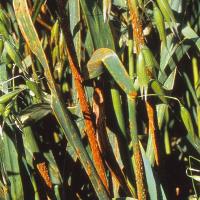Diagnosing stem rust in oats
Stem rust (Puccinia graminis f.sp. avenae)is a fungal foliar disease of oats that can cause up to 90% yield loss and also reduces grain quality in susceptible varieties. Widespread outbreaks are very damaging but rare. Regional outbreaks are more common, causing losses over limited areas. Stem rust is adapted to warmer conditions than leaf rust and is usually detected later in the season (mid-spring). Disease severity can increase extremely rapidly once a crop is uniformly infected.
What to look for
- Large reddish-brown pustules oval or elongated in shape on stems and sometimes both sides of leaves and leaf sheaths.
Plant
- Large reddish-brown pustules oval or elongated in shape on stems and sometimes both sides of leaves and leaf sheaths.
- In severe cases heads also become infected.
Plant
- Large reddish-brown pustules oval or elongated in shape on stems and sometimes both sides of leaves and leaf sheaths.
- In severe cases heads also become infected.
- Pustules become black in colour towards the end of the season.
Plant
What else could it be
| Condition | Similarities | Differences |
|---|---|---|
| Leaf pustules | Orange putsules that don't occur on stems |
Where did it come from?
- Stem rust requires domestic or wild oat host plants in order to survive from one season to the next. If summer rain allows a green bridge to develop, then the risk of early rust on crops can be significantly increased.
- A high level of stem rust in the previous season increases the chance of carryover into the next season.
- Stem rust development and spread is favoured by warm (18-30°C) humid conditions and an epidemic is more likely if the spring is suitably wet. The latent period (the approximate time taken for an infection to result in new spores) of stem rust is 7-10 days under these optimal temperature conditions.
- Rust can spread rapidly within and between wheat crops. Spores are readily dispersed by wind and can be carried on clothing. Thoroughly wash potentially contaminated clothes and shoes before visiting crops and consider farm biosecurity measures to minimise the likelihood of visitors introducing spores to your property.
- To identify stem rust pathotypes that are new to WA, growers and consultants are encouraged to send rust samples to the Australian cereal rust control program at the University of Sydney.
Management strategies

Resistant varieties

Green bridge control

Spraying fungicide
- Avoid sowing susceptible varieties. Use resistant or intermediate varieties wherever possible.
- Destroy greenbridge (volunteer and wild oats) at least four weeks prior to seeding.
- Foliar fungicide applications are most effective when applied as soon as rust appears. Use a registered fungicide at a registered rate. Ensure that withholding periods for both hay and grain are considered in timing of application.
Economic and financial considerations
To assist in assessing the economic risk and financial costs associated with various treatment strategies go to MyEconomicTool.
There may be other economic and financial implications that need to be considered when choosing a management option.
Where to go for expert help
Page last updated: Friday, 19 February 2016 - 2:36pm


